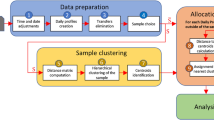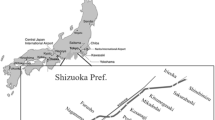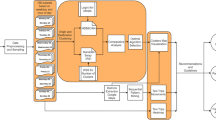Abstract
Smart card data from public transit systems has proven to be useful to understand the behaviors of public transit users. Relevant research has been done concerning: (1) the utilization of smart card data, (2) data mining techniques and (3) the utilization of data mining in smart card data. In prior research, the classification of user behavior has been based on trips when temporal and spatial classifications are considered to be separate processes. Therefore, it is of interest to develop a method based on users' daily behaviors that takes into account both spatial and temporal behaviors at the same time. In this work, a methodology is developed to classify smart card users' behaviors based on dynamic time warping (DTW), hierarchical clustering and a sampling method. A three-dimensional space–time prism plot demonstrates the efficiency of the algorithm.










Similar content being viewed by others
Explore related subjects
Discover the latest articles, news and stories from top researchers in related subjects.References
Agard B, Morency C, Trépanier M (2006) Mining public transport user behaviour from smart card data. IFAC Proc Vol 39(3): 399–404
Asakura Y, Iryo T, Nakajima Y, Kusakabe T (2012) Estimation of behavioural change of railway passengers using smart card data. Public Transp 4(1):1–16
Black PE (2006) Manhattan distance. Dictionary of algorithms and data structures. http://xlinux.nist.gov/dads//
Briand AS, Côme E, Trépanier M, Oukhellou L (2017) Analyzing year-to-year changes in public transport passenger behavior using smart card data. Transp Res Part C Emerg Technol 79:274–289
Bunker JM (2018) High volume bus stop upstream average waiting time for working capacity and quality of service. Public Transp 10(2):311–333
Ceapa I, Smith C, Capra L (2012) Avoiding the crowds: understanding tube station congestion patterns from trip data. In: Proceedings of the ACM SIGKDD international workshop on urban computing, pp 134–141. ACM
Chevalier F, Le Bellac J (2013) La classification. Université de Rennes. https://docplayer.fr/13650741-La-classification-2012-2013-fabien-chevalier-jerome-le-bellac.html
Chu KA, Chapleau R (2008) Enriching archived smart card transaction data for transit demand modeling. Transp Res Rec J Transp Res Board 2063:63–72
Covic F, Voß S (2019) Interoperable smart card data management in public mass transit. Public Transp 11(3):523–548
de Oña R, de Oña J (2015) Analysis of transit quality of service through segmentation and classification tree techniques. Transportmetrica A Transp Sci 11(5):365–387
Deza MM, Deza E (2009) Encyclopedia of distances, 3rd edn. Springer, Berlin
Diab EI, El-Geneidy AM (2013) Variation in bus transit service: understanding the impacts of various improvement strategies on transit service reliability. Public Transp 4(3):209–231
El-Geneidy AM, Surprenant-Legault J (2010) Limited-stop bus service: an evaluation of an implementation strategy. Public Transp 2(4):291–306
Farber S, O’Kelly M, Miller HJ, Neutens T (2015) Measuring segregation using patterns of daily travel behavior: a social interaction based model of exposure. J Transp Geogr 49:26–38
Ghaemi MS, Agard B, Nia VP, Trépanier M (2015) Challenges in spatial-temporal data analysis targeting public transport. IFAC-PapersOnLine 48(3):442–447
Ghaemi MS, Agard B, Trépanier M, Partovi Nia V (2017) A visual segmentation method for temporal smart card data. Transportmetrica A Transp Sci 13(5):381–404
Giorgino T (2009) Computing and visualizing dynamic time warping alignments in R: the dtw package. J Stat Softw 31(7):1–24
He L, Trépanier M (2015) Estimating the destination of unlinked trips in transit smart card fare data. Transp Res Rec J Transp Res Board 2535:97–104
He L, Trépanier M, Hickman M, Nassir N (2015) Validating and calibrating a destination estimation algorithm for public transport smart card fare collection systems (No. CIRRELT-2015-52). CIRRELT, Centre interuniversitaire de recherche sur les réseaux d'entreprise, la logistique et le transport= Interuniversity Research Centre on Enterprise Networks, Logistics and Transportation
He L, Trépanier M, Agard B (2019) Sampling method applied to the clustering of temporal patterns of public transit smart card users. CIRRELT research paper, CIRRELT-2019-30, p 18
He L, Agard B, Trépanier M (2020) A classification of public transit users with smart card data based on time series distance metrics and a hierarchical clustering method. Transportmetrica A Transp Sci 16(1):56–75
Imaz A, Habib KMN, Shalaby A, Idris AO (2015) Investigating the factors affecting transit user loyalty. Public Transp 7(1):39–60
Kieu LM, Bhaskar A, Chung E (2014) Transit passenger segmentation using travel regularity mined from Smart Card transactions data. In: Proc., Transportation Research Board 93rd annual meeting, National Research Council, Washington, DC
Kriegel HP, Kröger P, Sander J, Zimek A (2011) Density-based clustering. Wiley Interdiscipl Rev Data Min Knowl Discov 1(3):231–240
Kurauchi F, Schmöcker JD, Shimamoto H, Hassan SM (2014) Variability of commuters’ bus line choice: an analysis of oyster card data. Public Transp 6(1–2):21–34
Lee SG, Hickman M (2014) Trip purpose inference using automated fare collection data. Public Transp 6(1–2):1–20
Ma X, Wu YJ, Wang Y, Chen F, Liu J (2013) Mining smart card data for transit riders’ travel patterns. Transp Res Part C Emerg Technol 36:1–12
Morency C, Trépanier M, Agard B (2006) Analysing the variability of transit users behavior with smart card data. In: Intelligent transportation systems conference, 2006. ITSC'06. IEEE, pp 44–49
Morency C, Trépanier M, Agard B (2007) Measuring transit use variability with smart-card data. Transp Policy 14(3):193–203
Mori U, Mendiburu A, Lozano JA (2016) Distance measures for time series in R: the TSdist package. The R Journal 8(2):451–459
Nagy V, Horváth B, Horváth R (2017) Land-use zone estimation in public transport planning with data mining. Transp Res Procedia 27:1050–1057
Nishiuchi H, Kobayashi Y, Todoroki T, Kawasaki T (2018) Impact analysis of reductions in tram services in rural areas in Japan using smart card data. Public Transp 10(2):291–309
Pelletier MP, Trépanier M, Morency C (2011) Smart card data use in public transit: a literature review. Transp Res Part C Emerg Technol 19(4):557–568
Rokach L, Maimon O (2005) Clustering methods. Data mining and knowledge discovery handbook. Springer, Boston, pp 321–352
Shi X, Hangfei L (2014) The analysis of bus commuters’ travel characteristics using smart card data: the case of Shenzhen, China. In: 93rd annual meeting of the Transportation Research Board, Washington, D.C. (No. 14-2571)
Sun Y, Shi J, Schonfeld PM (2016) Identifying passenger flow characteristics and evaluating travel time reliability by visualizing AFC data: a case study of Shanghai Metro. Public Transp 8(3):341–363
Trépanier M, Barj S, Dufour C, Poilpré R (2004) Examen des potentialités d'analyse des données d'un système de paiement par carte à puce en transport urbain. In: Congrès de l'Association des transports du Canada
Trépanier M, Chapleau R, Tranchant N (2007) Individual trip destination estimation in a transit smart card automated fare collection system. J Intell Transp Syst 11(1):1–14
Viggiano C, Koutsopoulos HN, Wilson NH, Attanucci J (2017) Journey-based characterization of multi-modal public transportation networks. Public Transp 9(1–2):437–461
Yoon H, Shahabi C (2008) Robust time-referenced segmentation of moving object trajectories. In: 2008 eighth IEEE international conference on data mining, pp 1121–1126. IEEE
Yuan Y, Raubal M (2014) Measuring similarity of mobile phone user trajectories—a spatio-temporal edit distance method. Int J Geogr Inf Sci 28(3):496–520
Acknowledgements
The authors wish to acknowledge the support of the Société de transport de l’Outaouais (STO) for providing data, the Thales group and the Natural Science and Engineering Research Council of Canada (NSERC project RDCPJ 446107-12) for funding.
Author information
Authors and Affiliations
Corresponding author
Additional information
Publisher's Note
Springer Nature remains neutral with regard to jurisdictional claims in published maps and institutional affiliations.
Rights and permissions
About this article
Cite this article
He, L., Trépanier, M. & Agard, B. Space–time classification of public transit smart card users’ activity locations from smart card data. Public Transp 13, 579–595 (2021). https://doi.org/10.1007/s12469-021-00274-0
Accepted:
Published:
Issue Date:
DOI: https://doi.org/10.1007/s12469-021-00274-0




